check engine KIA BORREGO 2017 Repair Manual
[x] Cancel search | Manufacturer: KIA, Model Year: 2017, Model line: BORREGO, Model: KIA BORREGO 2017Pages: 548, PDF Size: 36.78 MB
Page 489 of 548
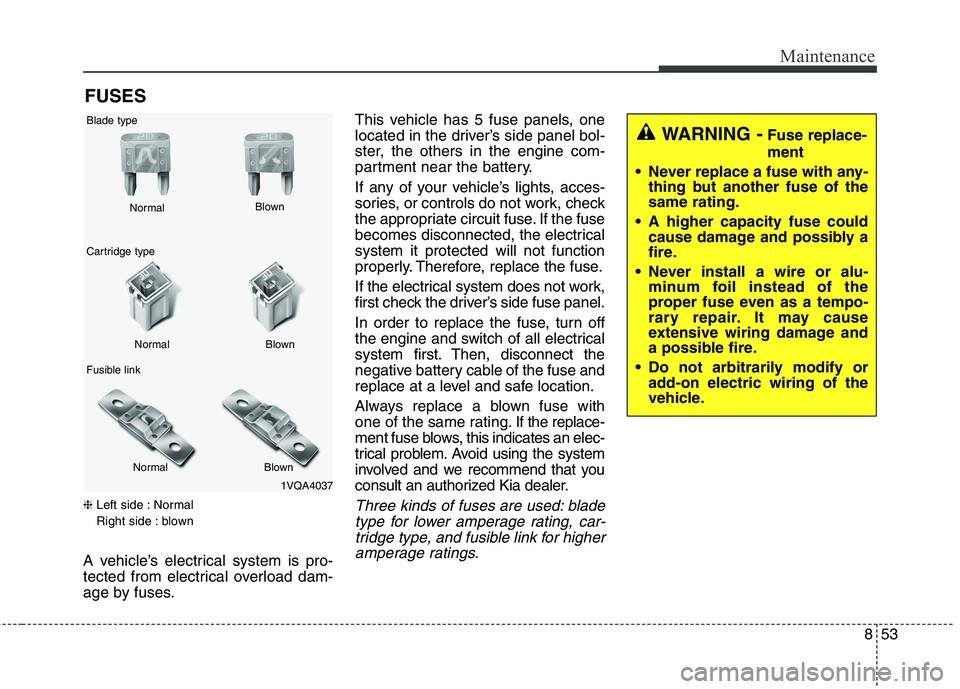
853
Maintenance
FUSES
❈ Left side : Normal
Right side : blown
A vehicle’s electrical system is pro-
tected from electrical overload dam-
age by fuses. This vehicle has 5 fuse panels, one
located in the driver’s side panel bol-
ster, the others in the engine com-
partment near the battery.
If any of your vehicle’s lights, acces-
sories, or controls do not work, check
the appropriate circuit fuse. If the fuse
becomes disconnected, the electricalsystem it protected will not function
properly. Therefore, replace the fuse.
If the electrical system does not work,
first check the driver’s side fuse panel.
In order to replace the fuse, turn off
the engine and switch of all electrical
system first. Then, disconnect the
negative battery cable of the fuse and
replace at a level and safe location.
Always replace a blown fuse with
one of the same rating. If
the replace-
ment fuse blows, this indicates an elec-
trical problem. Avoid using the system
involved and we recommend that you
consult an authorized Kia dealer.
Three kinds of fuses are used: blade
type for lower amperage rating, car-tridge type, and fusible link for higheramperage ratings.
WARNING - Fuse replace- ment
Never replace a fuse with any- thing but another fuse of the same rating.
A higher capacity fuse could cause damage and possibly a
fire.
Never install a wire or alu- minum foil instead of the
proper fuse even as a tempo-
rary repair. It may cause
extensive wiring damage and
a possible fire.
Do not arbitrarily modify or add-on electric wiring of the
vehicle.
1VQA4037
Normal
Normal
Blade type
Cartridge type
Fusible link Blown
Blown
Normal Blown
Page 491 of 548

855
Maintenance
Inner panel fuse replacement
1. Turn the ignition switch and allother switches off.
2. Open the fuse panel cover. 3. Pull the suspected fuse straight
out. Use the removal tool provided
in the main fuse box in the engine
compartment.
4. Check the removed fuse; replace it if it is blown.
Spare fuses are provided in the
instrument panel fuse panel (or inthe engine compartment fuse panel).
5. Push in a new fuse of the same rating, and make sure it fits tightly
in the clips.
If it fits loosely, we recommend that
you consult an authorized Kia dealer.
If you do not have a spare, use a fuse of the same rating from a circuit youmay not need for operating the vehi-cle, such as the cigarette lighter fuse.
If the headlights or taillights, stop-
lights, courtesy lamp, day time run-
ning lights (D.R.L) do not work and
the fuses are OK, check the fuse
panel in the engine compartment. If a
fuse is blown, it must be replaced.
OHM078022OHM078021
OHM078057
■ Front
■ Rear
Page 493 of 548
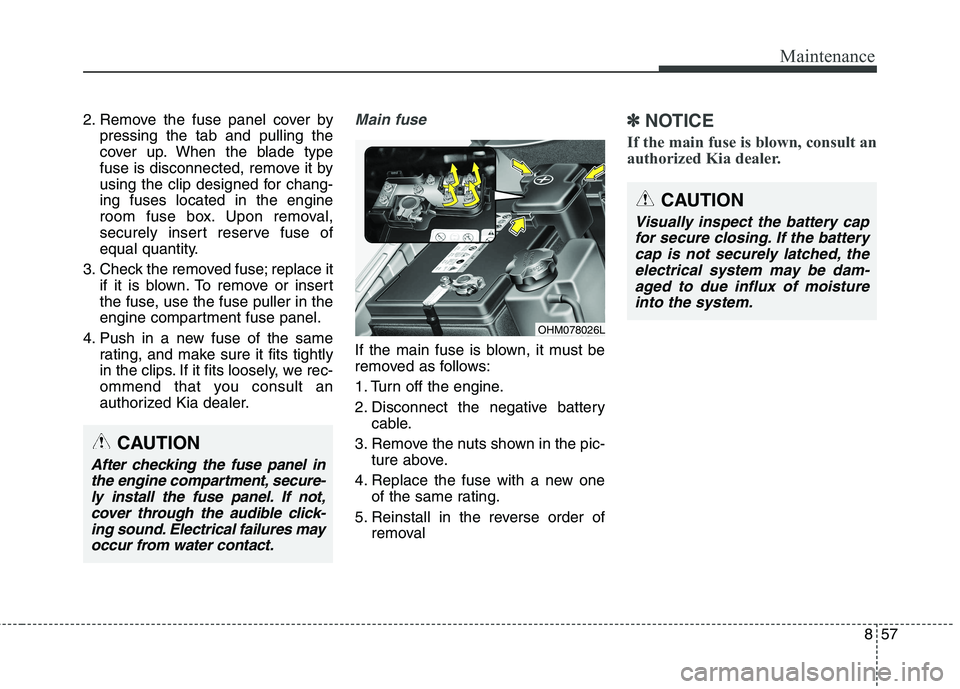
857
Maintenance
2. Remove the fuse panel cover bypressing the tab and pulling the
cover up. When the blade type
fuse is disconnected, remove it by
using the clip designed for chang-ing fuses located in the engine
room fuse box. Upon removal,
securely insert reserve fuse of
equal quantity.
3. Check the removed fuse; replace it if it is blown. To remove or insert
the fuse, use the fuse puller in the
engine compartment fuse panel.
4. Push in a new fuse of the same rating, and make sure it fits tightly
in the clips. If it fits loosely, we rec-
ommend that you consult an
authorized Kia dealer.Main fuse
If the main fuse is blown, it must be
removed as follows:
1. Turn off the engine.
2. Disconnect the negative batterycable.
3. Remove the nuts shown in the pic- ture above.
4. Replace the fuse with a new one of the same rating.
5. Reinstall in the reverse order of removal
✽✽ NOTICE
If the main fuse is blown, consult an
authorized Kia dealer.
CAUTION
Visually inspect the battery cap for secure closing. If the batterycap is not securely latched, theelectrical system may be dam- aged to due influx of moistureinto the system.
OHM078026L
CAUTION
After checking the fuse panel inthe engine compartment, secure-ly install the fuse panel. If not, cover through the audible click-ing sound. Electrical failures mayoccur from water contact.
Page 522 of 548
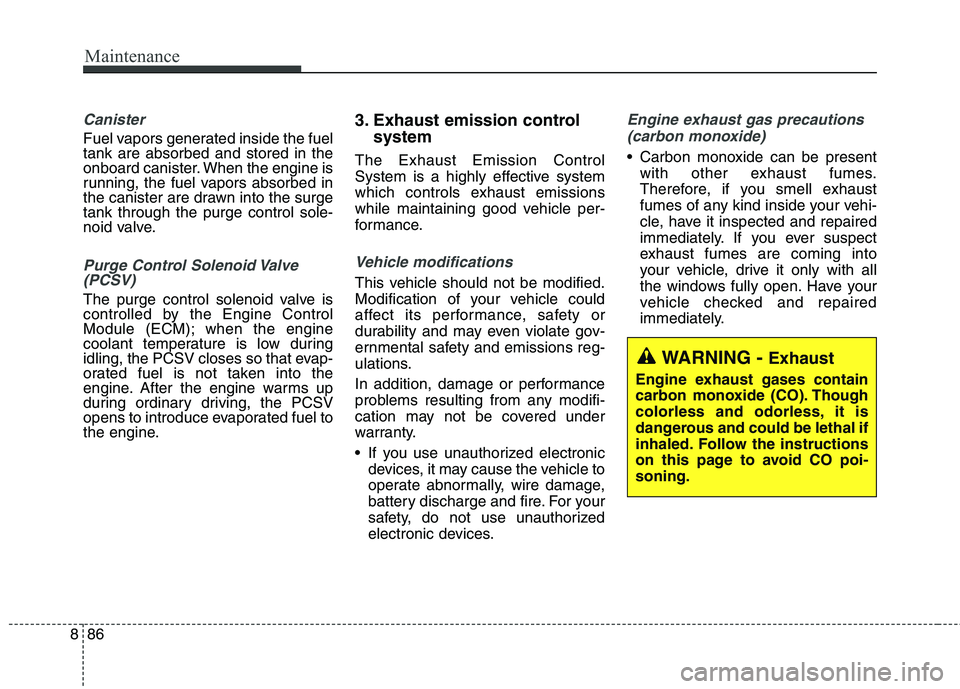
Maintenance
86
8
Canister
Fuel vapors generated inside the fuel tank are absorbed and stored in the
onboard canister. When the engine is
running, the fuel vapors absorbed in
the canister are drawn into the surgetank through the purge control sole-
noid valve.
Purge Control Solenoid Valve
(PCSV)
The purge control solenoid valve is
controlled by the Engine Control
Module (ECM); when the engine
coolant temperature is low during
idling, the PCSV closes so that evap-
orated fuel is not taken into the
engine. After the engine warms up
during ordinary driving, the PCSV
opens to introduce evaporated fuel to
the engine. 3. Exhaust emission control
system
The Exhaust Emission Control
System is a highly effective system
which controls exhaust emissions
while maintaining good vehicle per-
formance.
Vehicle modifications
This vehicle should not be modified.
Modification of your vehicle could
affect its performance, safety or
durability and may even violate gov-
ernmental safety and emissions reg-
ulations.
In addition, damage or performance
problems resulting from any modifi-
cation may not be covered under
warranty.
If you use unauthorized electronic devices, it may cause the vehicle to
operate abnormally, wire damage,
battery discharge and fire. For your
safety, do not use unauthorized
electronic devices.
Engine exhaust gas precautions
(carbon monoxide)
Carbon monoxide can be present with other exhaust fumes.
Therefore, if you smell exhaust
fumes of any kind inside your vehi-
cle, have it inspected and repaired
immediately. If you ever suspect
exhaust fumes are coming into
your vehicle, drive it only with all
the windows fully open. Have your
vehicle checked and repaired
immediately.
WARNING - Exhaust
Engine exhaust gases contain
carbon monoxide (CO). Though
colorless and odorless, it is
dangerous and could be lethal if
inhaled. Follow the instructions
on this page to avoid CO poi-soning.
Page 524 of 548

Failure to observe these precautions could result in damage to the catalyt-
ic converter and to your vehicle.
Additionally, such actions could void
your warranties.Diesel Particulate Filter (if equipped)
The Diesel Particulate Filter (DPF)
system removes the soot in the
exhaust gas.
Unlike a disposable air filter, the DPF
system automatically burns (oxidizes)
and removes the accumulated soot
according to the driving condition. In
other words, the active burning byengine control system and high
exhaust gas temperature caused by
normal/high driving condition burns
and removes the accumulated soot.
However, if the vehicle continues to
be driven at repeated short distance
or driven at low speed for a long
time, the accumulated soot may not
be automatically removed because
of low exhaust gas temperature.
More than a certain amount of sootdeposited, the malfunction indicator
light ( ) illuminates. When the malfunction indicator light
blinks, it may stop blinking by driving
the vehicle at more than 60 km/h (37mph) or at more than second gear
with 1500 ~ 2500 engine rpm for a
certain time (for about 25 minutes). If the malfunction indicator light ( )
continues to be blinked or the warn-
ing massage “Check exhaust system”
illuminates in spite of the procedure,
please visit an authorized Kia dealer
and the check the DPF system.
If you continue to drive with the mal-
function indicator light blinking for a
long time, the DPF system can bedamaged and fuel consumption can
be worsen.
CAUTION -
Diesel Fuel
(if equipped with DPF)
It is recommended to use the regulated automotive diesel fuelfor diesel vehicle equipped withthe DPF system.
If you use diesel fuel includinghigh sulfur (more than 50 ppmsulfur) and unspecified addi-tives, it can cause the DPF sys-tem to be damaged and white smoke can be emitted.
888
Maintenance
Page 532 of 548
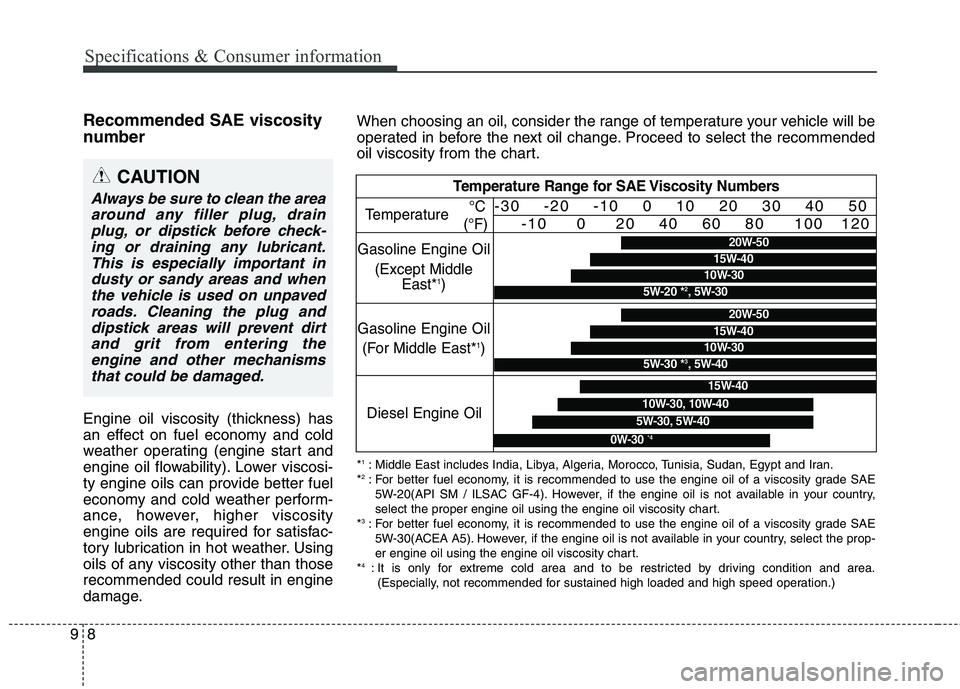
Specifications & Consumer information
8
9
Recommended SAE viscosity
number
Engine oil viscosity (thickness) has
an effect on fuel economy and cold
weather operating (engine start and
engine oil flowability). Lower viscosi-
ty engine oils can provide better fuel
economy and cold weather perform-
ance, however, higher viscosity
engine oils are required for satisfac-
tory lubrication in hot weather. Using
oils of any viscosity other than thoserecommended could result in engine
damage.
CAUTION
Always be sure to clean the area
around any filler plug, drainplug, or dipstick before check- ing or draining any lubricant.This is especially important industy or sandy areas and when the vehicle is used on unpavedroads. Cleaning the plug anddipstick areas will prevent dirt and grit from entering theengine and other mechanismsthat could be damaged.
When choosing an oil, consider the range of temperature your vehicle will be
operated in before the next oil change. Proceed to select the recommended
oil viscosity from the chart.
Temperature Range for SAE Viscosity Numbers
Temperature
Gasoline Engine Oil (Except Middle East* 1
)
Gasoline Engine Oil (For Middle East* 1
)
°C
(°F)-30 -20 -10 0 10 20 30 40 50 -10 0 20 40 60 80 100 120
*1
: Middle East includes India, Libya, Algeria, Morocco, Tunisia, Sudan, Egypt and Iran.
* 2
: For better fuel economy, it is recommended to use the engine oil of a viscosity grade SAE
5W-20(API SM / ILSAC GF-4). However, if the engine oil is not available in your country,
select the proper engine oil using the engine oil viscosity chart.
* 3
: For better fuel economy, it is recommended to use the engine oil of a viscosity grade SAE
5W-30(ACEA A5). However, if the engine oil is not available in your country, select the prop-
er engine oil using the engine oil viscosity chart.
* 4
: It is only for extreme cold area and to be restricted by driving condition and area.
(Especially, not recommended for sustained high loaded and high speed operation.)
20W-50
10W-30
15W-40
5W-20 * 2
, 5W-30
20W-50
10W-30
15W-40
5W-30 * 3
, 5W-40
Diesel Engine Oil5W-30, 5W-40
15W-40
10W-30, 10W-40
0W-30 *4
Page 538 of 548
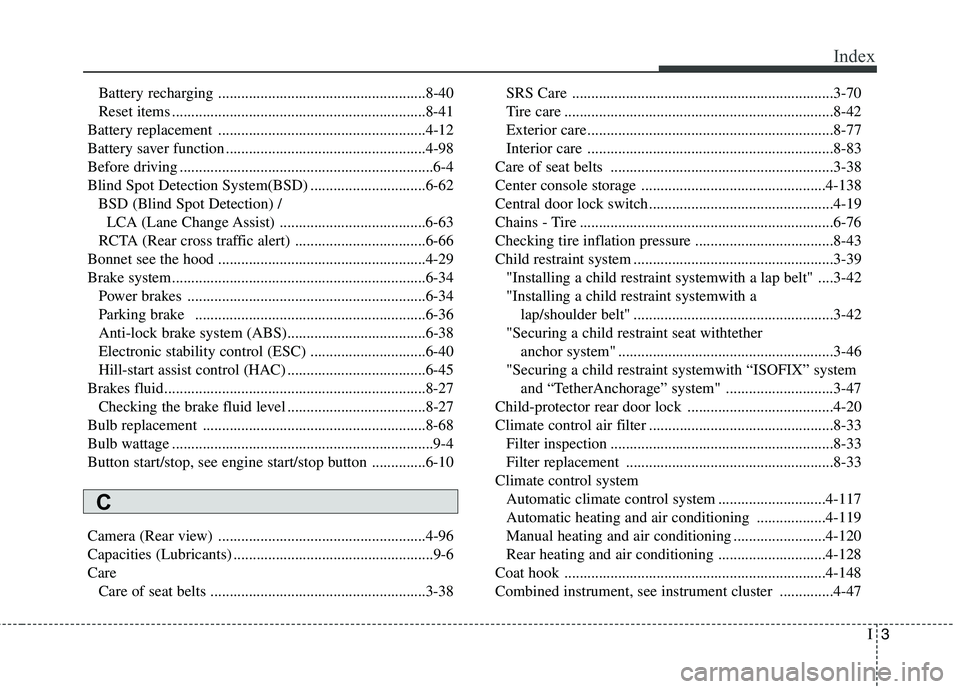
I3
Index
Battery recharging ......................................................8-40
Reset items ..................................................................8-41
Battery replacement ......................................................4-12
Battery saver function ....................................................4-98
Before driving ..................................................................6-4
Blind Spot Detection System(BSD) ..............................6-62 BSD (Blind Spot Detection) /LCA (Lane Change Assist) ......................................6-63
RCTA (Rear cross traffic alert) ..................................6-66
Bonnet see the hood ......................................................4-29
Brake system..................................................................6-34 Power brakes ..............................................................6-34
Parking brake ............................................................6-36
Anti-lock brake system (ABS)....................................6-38
Electronic stability control (ESC) ..............................6-40
Hill-start assist control (HAC) ....................................6-45
Brakes fluid....................................................................8-27 Checking the brake fluid level ....................................8-27
Bulb replacement ..........................................................8-68
Bulb wattage ....................................................................9-4
Button start/stop, see engine start/stop button ..............6-10
Camera (Rear view) ......................................................4-96
Capacities (Lubricants) ....................................................9-6Care Care of seat belts ........................................................3-38 SRS Care ....................................................................3-70
Tire care ......................................................................8-42
Exterior care ................................................................8-77
Interior care ................................................................8-83
Care of seat belts ..........................................................3-38
Center console storage ................................................4-138
Central door lock switch................................................4-19
Chains - Tire ..................................................................6-76
Checking tire inflation pressure ....................................8-43
Child restraint system ....................................................3-39 "Installing a child restraint systemwith a lap belt" ....3-42"Installing a child restraint systemwith a lap/shoulder belt" ....................................................3-42
"Securing a child restraint seat withtether anchor system" ........................................................3-46
"Securing a child restraint systemwith “ISOFIX” system and “TetherAnchorage” system" ............................3-47
Child-protector rear door lock ......................................4-20
Climate control air filter ................................................8-33 Filter inspection ..........................................................8-33
Filter replacement ......................................................8-33
Climate control system Automatic climate control system ............................4-117
Automatic heating and air conditioning ..................4-119
Manual heating and air conditioning ........................4-120
Rear heating and air conditioning ............................4-128
Coat hook ....................................................................4-148
Combined instrument, see instrument cluster ..............4-47
C
Page 540 of 548
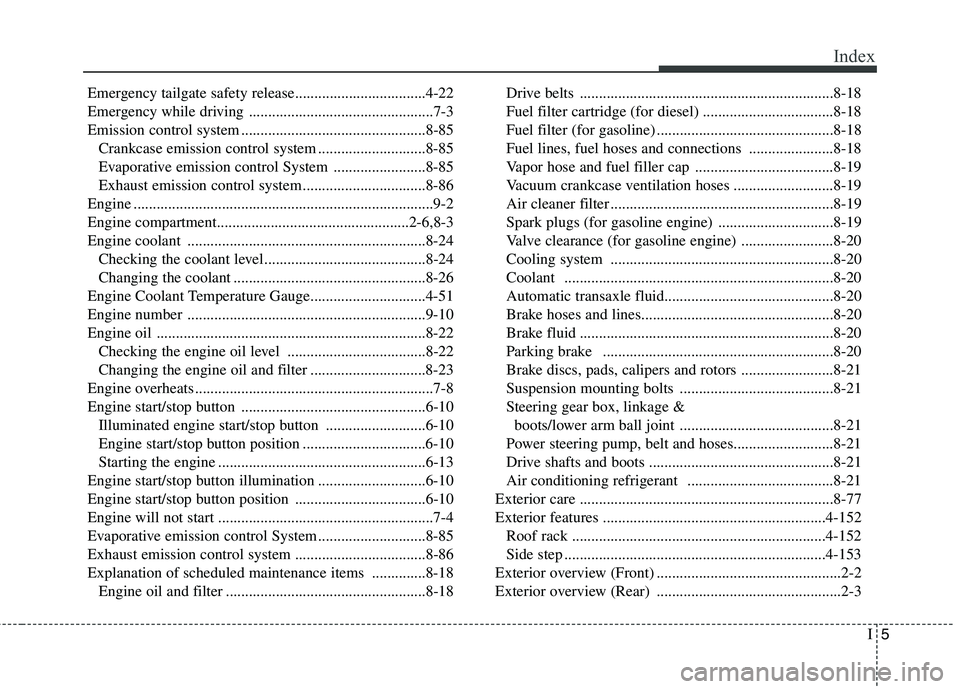
I5
Index
Emergency tailgate safety release..................................4-22
Emergency while driving ................................................7-3
Emission control system ................................................8-85
Crankcase emission control system ............................8-85
Evaporative emission control System ........................8-85
Exhaust emission control system ................................8-86
Engine ..............................................................................9-2
Engine compartment..................................................2-6,8-3
Engine coolant ..............................................................8-24 Checking the coolant level..........................................8-24
Changing the coolant ..................................................8-26
Engine Coolant Temperature Gauge..............................4-51
Engine number ..............................................................9-10
Engine oil ......................................................................8-22 Checking the engine oil level ....................................8-22
Changing the engine oil and filter ..............................8-23
Engine overheats ..............................................................7-8
Engine start/stop button ................................................6-10 Illuminated engine start/stop button ..........................6-10
Engine start/stop button position ................................6-10
Starting the engine ......................................................6-13
Engine start/stop button illumination ............................6-10
Engine start/stop button position ..................................6-10
Engine will not start ........................................................7-4
Evaporative emission control System ............................8-85
Exhaust emission control system ..................................8-86
Explanation of scheduled maintenance items ..............8-18 Engine oil and filter ....................................................8-18 Drive belts ..................................................................8-18
Fuel filter cartridge (for diesel) ..................................8-18
Fuel filter (for gasoline) ..............................................8-18
Fuel lines, fuel hoses and connections ......................8-18
Vapor hose and fuel filler cap ....................................8-19
Vacuum crankcase ventilation hoses ..........................8-19
Air cleaner filter ..........................................................8-19
Spark plugs (for gasoline engine) ..............................8-19
Valve clearance (for gasoline engine) ........................8-20
Cooling system ..........................................................8-20Coolant ......................................................................8-20Automatic transaxle fluid............................................8-20
Brake hoses and lines..................................................8-20
Brake fluid ..................................................................8-20
Parking brake ............................................................8-20
Brake discs, pads, calipers and rotors ........................8-21
Suspension mounting bolts ........................................8-21
Steering gear box, linkage & boots/lower arm ball joint ........................................8-21
Power steering pump, belt and hoses..........................8-21
Drive shafts and boots ................................................8-21
Air conditioning refrigerant ......................................8-21
Exterior care ..................................................................8-77
Exterior features ..........................................................4-152 Roof rack ..................................................................4-152
Side step ....................................................................4-153
Exterior overview (Front) ................................................2-2
Exterior overview (Rear) ................................................2-3
Page 544 of 548
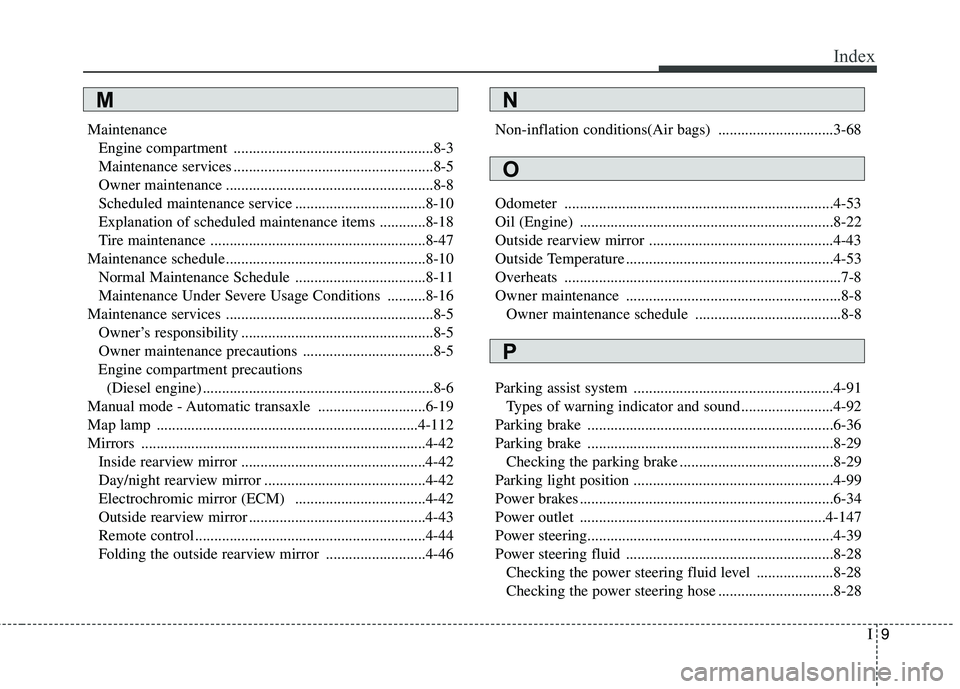
I9
Index
Maintenance
Engine compartment ....................................................8-3
Maintenance services ....................................................8-5
Owner maintenance ......................................................8-8
Scheduled maintenance service ..................................8-10
Explanation of scheduled maintenance items ............8-18
Tire maintenance ........................................................8-47
Maintenance schedule....................................................8-10 Normal Maintenance Schedule ..................................8-11
Maintenance Under Severe Usage Conditions ..........8-16
Maintenance services ......................................................8-5 Owner’s responsibility ..................................................8-5
Owner maintenance precautions ..................................8-5
Engine compartment precautions (Diesel engine) ............................................................8-6
Manual mode - Automatic transaxle ............................6-19
Map lamp ....................................................................4-112
Mirrors ..........................................................................4-42 Inside rearview mirror ................................................4-42
Day/night rearview mirror ..........................................4-42
Electrochromic mirror (ECM) ..................................4-42
Outside rearview mirror ..............................................4-43
Remote control ............................................................4-44
Folding the outside rearview mirror ..........................4-46 Non-inflation conditions(Air bags) ..............................3-68
Odometer ......................................................................4-53
Oil (Engine) ..................................................................8-22
Outside rearview mirror ................................................4-43
Outside Temperature ......................................................4-53
Overheats ........................................................................7-8
Owner maintenance ........................................................8-8
Owner maintenance schedule ......................................8-8
Parking assist system ....................................................4-91 Types of warning indicator and sound........................4-92
Parking brake ................................................................6-36
Parking brake ................................................................8-29 Checking the parking brake ........................................8-29
Parking light position ....................................................4-99
Power brakes ..................................................................6-34
Power outlet ................................................................4-147
Power steering................................................................4-39
Power steering fluid ......................................................8-28 Checking the power steering fluid level ....................8-28
Checking the power steering hose ..............................8-28
M
O
N
P